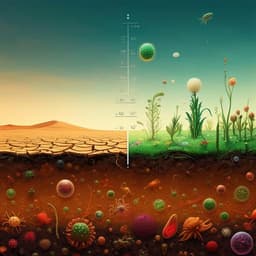
Environmental Studies and Forestry
Ecosystem productivity has a stronger influence than soil age on surface soil carbon storage across global biomes
C. Plaza, P. García-palacios, et al.
This groundbreaking study by César Plaza, Pablo García-Palacios, and their colleagues reveals that ecosystem productivity plays a more critical role than soil age in determining soil carbon fractions across diverse global ecosystems. The findings stress the need to protect productive ecosystems to maintain vital soil carbon reserves.
~3 min • Beginner • English
Introduction
Surface soil carbon in the form of organic matter underpins key ecosystem services including climate regulation, plant production, nutrient cycling, and water storage and purification. Globally, soil carbon content tends to be greater in cold, mesic environments than in warm, xeric ecosystems, and often increases during early stages of ecosystem development before declining during retrogression over millennia. Gains and losses of soil carbon reflect changes in primary productivity and stabilization/destabilization processes, partly governed by interactions of organic matter with minerals. Long-term preservation is mediated by occlusion within aggregates and organo-mineral associations that limit microbial access and increase energetic costs for decomposition. Consequently, mineral-associated organic carbon may be less vulnerable to microbial decomposition and warming-induced respiration than unprotected particulate and free light fractions.
While mineral control over soil carbon has been demonstrated across temporal and spatial gradients, most insights come from single chronosequences, leaving uncertain how the proportion of mineral-protected versus free organic carbon changes over centuries to millennia across diverse ecosystems. Addressing this knowledge gap is critical for improving understanding of soil carbon storage and turnover at large scales, reducing uncertainties in land carbon models, and informing management to sustain soil ecosystem services. Here, using 16 globally distributed chronosequences spanning contrasting climates, parent materials, and vegetation types, the study asks how and why the amount and proportion of surface (0–10 cm) soil organic carbon in free light, occluded light, and mineral-associated fractions change during soil development across biomes.
Literature Review
Prior work indicates that soil carbon content is higher in colder, moister regions and follows a hump-shaped trajectory with ecosystem development, increasing in early succession and declining during retrogression. Mineral interactions are central to long-term soil carbon preservation via aggregate occlusion and organo-mineral associations. Single-chronosequence studies in Hawaii and California showed positive relationships between soil carbon and mineral reactivity, with weathering initially enhancing and later reducing the soil’s capacity to stabilize carbon, particularly where short-range order and non-crystalline minerals are abundant. Broader-scale studies have highlighted geochemical and climatic controls on soil carbon storage and partitioning among particulate and mineral-associated pools. However, comprehensive assessments of how mineral protection versus free organic carbon proportions vary with soil age across multiple ecosystems remained limited, motivating the present multi-chronosequence approach.
Methodology
Study design: The authors compiled 16 long-term soil chronosequences from six continents and nine countries, each with 4–10 sites spanning hundreds to millions of years of ecosystem development. Chronosequences covered diverse parent materials (volcanic, sedimentary, sand dunes), climates (tropical, temperate, continental, polar, arid), and vegetation (grasslands, shrublands, forests, croplands). Climatic classifications followed Köppen-Geiger; mean annual temperature and precipitation were from WorldClim.
Field sampling: At each site, a 50×50 m plot was established. Five composite topsoil samples (0–10 cm; excluding litter) were collected per plot using an open-tube sampler to avoid compaction (total 435 samples). Samples were sieved to 2 mm. Bulk density was determined as dry mass per field volume. Fine texture (clay + silt %) was measured by sieving and sedimentation.
Vegetation and productivity: Total plant cover was surveyed via three 50 m transects (line-intercept method). Ecosystem productivity was proxied by NDVI (MODIS, 250 m; 2008–2017 mean).
Soil organic carbon analyses and fractionation: Total organic carbon (TOC) on bulk soils was measured by dichromate oxidation (K2Cr2O7–H2SO4, 150 °C, 30 min). One composite sample per site was fractionated using a density-based scheme (NaI, 1.85 g mL−1) to isolate: (i) free light fraction (unprotected), (ii) occluded light fraction (intra-aggregate, physically protected), and (iii) mineral-associated fraction (sorbed to minerals). Following gentle mixing and centrifugation, the free light fraction was isolated; the heavy fraction was sonicated at 1500 J g−1 to release occluded light organic matter, then separated from the remaining mineral-associated fraction. Fractions were dried (60 °C), ground, and analyzed for organic carbon by dry combustion (Flash 2000 CN analyzer). Mineral-associated fractions were acid-fumigated to remove carbonates prior to analysis. Fractionation and analyses were performed at CSIC (Madrid). The sum of fraction C closely matched bulk TOC (r = 0.987, p < 0.001, n = 87). Occluded light C averaged <10% of total fraction C across sites.
Cross-validation: A subset of samples (n = 24) was also subjected to size-fractionation (after dispersion with sodium hexametaphosphate) to compare with density fractions, showing strong correlations between analogous pools (e.g., mineral-associated by density vs particulate by size, r = 0.687, p < 0.001), supporting consistency across methods.
Soil respiration and temperature sensitivity: Basal heterotrophic respiration was measured on 1 g of bulk soil (per plot) over 16 days following a 1-week pre-incubation. For a subset of eight chronosequences spanning major biomes, temperature sensitivity (Q10) of soil respiration was determined from short incubations at 5, 15, and 25 °C using the MicroResp approach, calculating Q10 as exp{β(T)}; higher Q10 indicates greater vulnerability of soil C to warming.
Data analysis: The proportion of C in each fraction was computed as fraction C × 100 / sum of all fraction C. Linear mixed-effects models tested effects of ecosystem productivity (NDVI), soil age class (thousands, hundreds of thousands, millions of years), and their interactions on the proportions of free light and mineral-associated C, with chronosequence as a random intercept; a tea-cropped subtropical chronosequence (TA) was excluded from this analysis due to altered productivity. Relationships between C fraction proportions, soil respiration, and Q10 were also assessed using mixed-effects models controlling for NDVI and fine texture. Structural equation modeling (SEM) evaluated direct and indirect effects of mean annual temperature (MAT), mean annual precipitation (MAP), vegetation (forest vs other), NDVI, fine texture, soil age (quantitative/qualitative indices), and spatial distance on the proportions of free light and mineral-associated C. Model fit and path coefficients were reported; spatial autocorrelation was accounted for via geographic distance among plots.
Key Findings
- Across 16 chronosequences, the proportions of free light and mineral-associated C varied widely among ecosystems but changed little with soil age within chronosequences.
- Linear mixed-effects models showed ecosystem productivity significantly influenced the proportion of free light (p = 0.002) and mineral-associated (p = 0.005) C, whereas soil age class effects were not significant (p > 0.05).
- Occluded light C comprised a minor share (<10% on average) of surface soil organic C across sites; free light and mineral-associated fractions dominated stocks.
- Warm, wet, and productive ecosystems (tropical and temperate forests) were consistently dominated by free light C over mineral-associated C (7/8 such chronosequences; 35/45 plots), and had relatively higher TOC contents.
- Cold and arid, low-productivity ecosystems (e.g., desert shrublands, cold grasslands) were dominated by mineral-associated C (7/8 chronosequences; 29/42 plots).
- Illustrative contrasts: semiarid volcanic forest (AZ) averaged 56% mineral-associated C, whereas tropical volcanic rainforest (HA) was dominated by free light C with mineral-associated C <2% on average; cold grasslands in Colorado (CO) averaged 61% mineral-associated C, while warmer California (CAL) grasslands averaged 35% mineral-associated C.
- Exceptions: A highly productive continental forest (MI) stored most C in free light OM despite being a cold ecosystem; a subtropical tea-cropped chronosequence in Taiwan (TA) had low TOC and was dominated by mineral-associated C, indicating land-use conversion reduced unprotected C pools.
- The proportion of free light C was positively related to microbial respiration rates, whereas mineral-associated C was negatively related. In the subset with temperature assays, the proportion of free light C was positively associated with respiration temperature sensitivity (Q10), and mineral-associated C showed the opposite trend (model p-values: effects of fraction proportion on respiration/Q10 were significant; e.g., P < 0.001 and P = 0.005 in Fig. 2 panels).
- SEM identified ecosystem productivity (NDVI) and fine texture (% clay + silt) as key drivers: higher MAP, MAT, and forest cover increased NDVI, which increased the proportion of free light C and decreased mineral-associated C. Mineral-associated C was positively associated with fine texture and indirectly with soil age. Model fit statistics indicated good fit (e.g., χ2 = 0.27, P = 0.59; RMSEA = 0.00).
Discussion
The study demonstrates that contemporary ecosystem properties, especially productivity and soil texture, exert stronger control over the partitioning of surface soil carbon between unprotected (free light) and mineral-associated (protected) fractions than does soil age over timescales of centuries to millennia. This directly answers the central question by showing that, within chronosequences, the relative mineral protection of surface soil C is comparatively stable with age but varies markedly among ecosystem types.
In productive tropical and temperate forests, free light C predominance corresponds to higher microbial respiration and greater temperature sensitivity, implying larger vulnerability of these surface C pools to reductions in productivity (e.g., disturbance, land-use change) and to warming. Conversely, the dominance of mineral-associated C in cold and arid systems indicates greater physicochemical protection and lower sensitivity of surface C to warming, despite lower overall C stocks. The SEM clarifies mechanistic pathways: climate and vegetation increase NDVI, which shifts C toward free light fractions, while fine-textured soils promote mineral association and protection. The observed exceptions (e.g., MI and TA) reinforce the broader pattern and underscore the role of land use and local contingencies. Collectively, the findings refine understanding of soil C stability and its temperature dependence across biomes, with implications for predicting soil C feedbacks to climate change and for management aimed at conserving ecosystem productivity to safeguard surface soil C.
Conclusion
Mineral protection of surface soil carbon varies strongly among ecosystem types but changes relatively little with soil development across centuries to millennia. Warm, wet, and productive forests tend to store more surface soil C in free organic matter fractions that are more vulnerable to microbial decomposition and warming, whereas cold and arid ecosystems store more in mineral-associated fractions influenced by soil texture and less vulnerable to warming. These insights advance understanding of soil C stability dynamics across global biomes and highlight the importance of maintaining ecosystem productivity to protect surface soil C.
Future research should integrate soil mineralogical data and deeper soil profiles to assess how mineral weathering, parent material, and depth interact with soil age to influence C stabilization, and to improve representation of protected versus unprotected C pools in land carbon models.
Limitations
- Results pertain to the surface soil layer (0–10 cm) and should not be directly extrapolated to whole-profile carbon stocks.
- Global extrapolation of changes in soil C storage is not warranted from these chronosequences alone.
- Soil age is an imperfect proxy for mineral weathering progression, which depends on parent material and site-specific processes; regressive processes like erosion cannot be ruled out without detailed mineralogical data.
- Broad climatic and ecosystem drivers may mask site-specific geochemical effects; prior single-chronosequence studies indicate mineralogy and weathering can strongly control C stabilization, particularly in deeper layers of moist systems.
- The study design did not allow evaluation of interactions between soil depth and age on C stabilization, representing a key area for future work.
Related Publications
Explore these studies to deepen your understanding of the subject.







